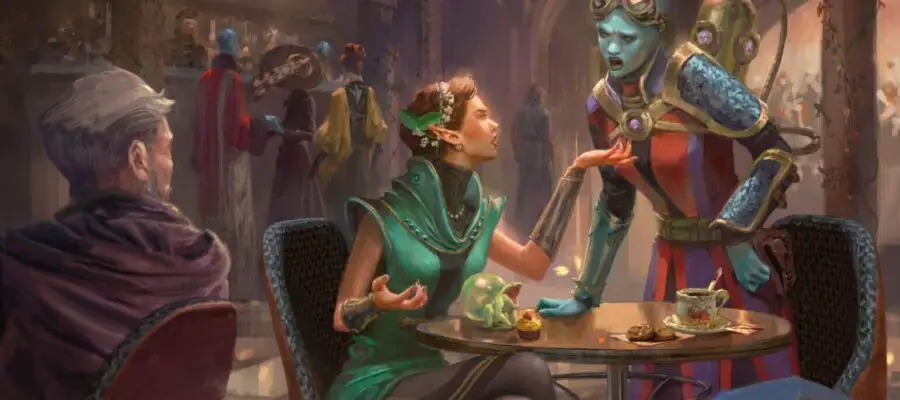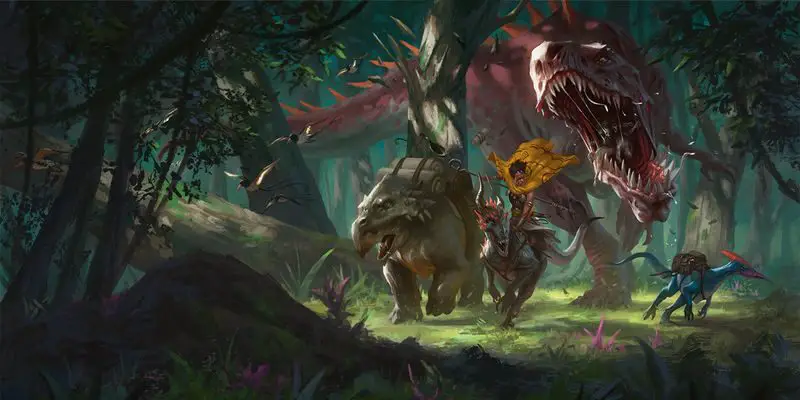Featured image credit for handling player problems to Wizards of the Coast’s D&D 5e Guildmasters’ Guide to Ravnica book.
Disclaimer: This article contains affiliate links that add gold to our coffers.
A player stares at his sheet. It’s been five minutes since his turn started, and the table’s growing restless.
The cleric is deep into negotiations with the shopkeep—until the rogue gets bored and slits the man’s throat.
The DM sits back down, weary of another argument over rules; it wasn’t the first, and it certainly won’t be the last.
The paladin denies reading the module—but as she leads the party through the dungeon, she avoids every trap perfectly.
Every rose has its thorns, and no D&D table is perfect. Players and DMs have their own preferences, needs, and perspectives—and these styles can clash. Misunderstandings and miscommunications can also cause friction at the table, turning a fun game into a stressful nightmare.
Any player can and should try to resolve problems as they arise. Even so—whether for good or ill—DMs are widely expected to be their table’s mediator. But how?
D&D’s Social Contract
A “social contract” is an unspoken agreement—a commitment to work together toward a greater end. In D&D, the social contract is simple: All players (and the DM) will do their best to make sure that everyone else at the table has a good time.
Whether it’s slow play, murderhobo-ism, defying the DM, or metagaming, there are endless ways for players to break the social contract. Resolving those issues, however, can be much harder.
As the table’s de facto leader and the creator of the campaign, it can be easy—even tempting—for DMs to use in-game consequences in an attempt to solve the problem. Threats of disadvantage to speed up the slow-player. Bounty hunters to punish the murderhobo. Harsh rulings to dissuade the defier. Last-minute story tweaks to confuse the metagamer.
But these in-game “solutions” teach the wrong lessons: Because they conflate “players” and “player characters,” they encourage players to find a way to beat the DM, rather than working with the DM. They raise tensions around the table, creating frustration and stress—especially if their purpose is not clearly understood. Most importantly, they corrupt the DM’s role from “storyteller” to “judge,” forcing them to spend time handing out punishments instead of playing the game that they love.
At their core, all D&D problems are “people problems”, requiring people-driven—not game-driven—solutions. Importantly, social contracts are not dictators’ demands. They are common agreements by everybody—including problematic players—to come together and create a positive experience. If a DM is to solve a player’s problem, that solution must come through collaboration and mutual understanding; the DM can’t act alone.
Striking the Right Tone
It can be tough to start an out-of-character conversation about a problem. Players and DMs are often uncomfortable with confrontation, and it can be tempting to ignore an issue in order to avoid the risk of an outright explosion.
Don’t give into this temptation! While combative disagreements can feel painful in the moment, bottled-up problems create a much more sickly, seeping poison, turning molehills into mountains and dividing players with bitterness and mistrust.
Instead, approach your player like a friend, inviting collaboration and a common solution. After all, if a player is acting out, they’re probably doing so as a result of their own frustrations or anxieties. A metagamer may fear defeat. A slow player may fear making the “wrong decision.” A murderhobo may be bored or impulsive.
Remember: Few players want to cause others pain or frustration. If a player is a part of the problem, they must be part of the solution—and that means compromise.
Five Steps for Solving a Player Problem
Let’s assume that you’ve spoken with other members of your table and confirmed that this problem is troubling them as well. Where do you start?
First—reach out to the problematic player in private. Bringing these issues up in a public channel might make that player feel like they’re being ganged up on, or like they’re being tarred and feathered for the group’s amusement. Instead, work to create a safe, familiar, and comfortable space to speak.
Second—remind the player that you value their participation. Mention the contributions they bring to the table, and let them know that you want to make sure they’re having fun.
Third—invite them to speak. Briefly describe a specific and recent instance of problematic behavior—without characterizing or condemning their actions—and ask them what motivated their conduct. If they seemed frustrated or stressed at the time, ask them if they’ve been enjoying the campaign and remind them (again) that your first priority is making sure that they have fun.
Fourth—if the player seems embarrassed or upset by their behavior, invite them to describe their ideal outcome—what the campaign should look like once this issue is addressed—and to propose possible solutions. If the player doesn’t think that they’ve done anything wrong, politely and empathetically share your feelings about the problem, as well as your own ideal outcome for the situation. As you do, make sure to follow a few key principles:
- Assume the best of others. Don’t assume that the player is acting out of malice or ignorance. Assume that they also want everyone at the table to have fun.
- Focus on your own feelings. Instead of condemning the player’s behavior, talk about how it makes you (and the rest of the table) feel. A player might deny that their behavior was wrong—but they can’t deny how it impacted others.
- Foster collaboration, not critique. Remember that the situation is the problem, not the player. Don’t scold or shame the player for doing something wrong. Instead, treat them as a partner in solving the problem.
Fifth—brainstorm compromises and potential accommodations. Perhaps a slow player would benefit from a simpler character sheet or an accessible flowchart of combat tactics. Perhaps a murderhobo would enjoy more opportunities for combat, or would appreciate being included in other players’ roleplay. Perhaps a defiant player really does have a point about some of the rules you’ve been (mis)applying. Perhaps a metagaming player can be reassured that defeat does not equal death or be given another outlet for their analytical energies.
This conversation may not be easy. It will likely not be brief. You must be patient, mature, and considerate of others’ feelings. But through it all, remember this:
Presumably, you invited this person to your table because they were a friend, or because you wanted them to become one. They deserve to be treated accordingly.
Enforcement & Accountability
Talk is cheap—action matters more. Once you’ve come to an understanding with a problematic player, how do you make sure they keep up their end of the bargain?
It’s important, first, to understand that “acting out” doesn’t always come from a place of malice. It may come from habit, impulse, misunderstanding, or mistake. Nobody is perfect; there will, doubtlessly, be slip-ups. The important thing to do, then, is minimize the frequency of those slip-ups and work swiftly and gently to minimize their impact when they occur.
First, assuming that your player is working in good faith to address these issues, try to create accommodations or (consensual) accountability measures that make slip-ups less likely. If you’re trying to speed up a slow player, perhaps a one-minute turn timer—with their permission—might do the trick.
Next, use the social contract to your advantage, giving its strictures the full force of physics. If you’re the DM, nothing happens in your world if you don’t allow it. A murderhobo can say, “I attack the shopkeeper!”, but they can’t unsheathe their sword—let alone deal damage—unless you allow it. When these events occur, gently remind the player about their agreement, and continue the game only once everyone at the table is back on the same page.
If you suspect that a player is not acting in good faith—or if a player refuses to change their behavior—you (and the table) must make a decision. As the infamous “Resolving RPG Behavioral Problems” chart suggests, if a player’s behavior is bothering other members of the table and that player refuses to change, you have to decide whether the harm caused by that player’s behavior is worth keeping them at the table.
Remember: It’s better to not play D&D at all than to play a D&D campaign you don’t enjoy. More importantly, if a player is making the game worse for everyone else, you owe that player no obligation to let them keep playing.
If you decide that removing a player is necessary, approach it with empathy and compassion. Don’t say, “We’re kicking you out because you make the game terrible.” Try instead, “I don’t think I can run the kind of game you’re looking for.”
In Conclusion
It can be difficult to approach a player with frustrations in mind. These conversations aren’t easy, especially if a player is reluctant to work with you.
Always remember, though, that so long as you act with respect, compassion, and consideration, you’re still working toward a positive goal: the creation of an enjoyable and meaningful experience. If, by having these conversations, you’re able to create a happier, healthier campaign, you can sleep soundly in the knowledge that you’ve done right by your table.
About the Author: DragnaCarta is a guest writer for FlutesLoot.com and a veteran DM with 12+ years of experience. He is the author of the popular “Curse of Strahd: Reloaded” campaign guide and the Dungeon Master and director for the Curse of Strahd livestream “Twice Bitten.” You can get his personal RPG mentoring plus early access to projects by joining his Patreon.
Cast Message in the comments section below to ask DragnaCarta about this topic. You can find other articles by DragnaCarta on FlutesLoot.com.




